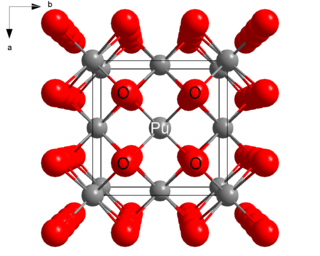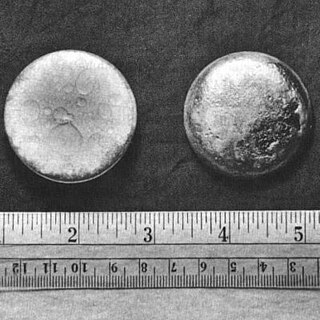
Radioactive waste is a type of hazardous waste that contains radioactive material. Radioactive waste is a result of many activities, including nuclear medicine, nuclear research, nuclear power generation, nuclear decommissioning, rare-earth mining, and nuclear weapons reprocessing. The storage and disposal of radioactive waste is regulated by government agencies in order to protect human health and the environment.

The nuclear fuel cycle, also called nuclear fuel chain, is the progression of nuclear fuel through a series of differing stages. It consists of steps in the front end, which are the preparation of the fuel, steps in the service period in which the fuel is used during reactor operation, and steps in the back end, which are necessary to safely manage, contain, and either reprocess or dispose of spent nuclear fuel. If spent fuel is not reprocessed, the fuel cycle is referred to as an open fuel cycle ; if the spent fuel is reprocessed, it is referred to as a closed fuel cycle.

Nuclear reprocessing is the chemical separation of fission products and actinides from spent nuclear fuel. Originally, reprocessing was used solely to extract plutonium for producing nuclear weapons. With commercialization of nuclear power, the reprocessed plutonium was recycled back into MOX nuclear fuel for thermal reactors. The reprocessed uranium, also known as the spent fuel material, can in principle also be re-used as fuel, but that is only economical when uranium supply is low and prices are high. Nuclear reprocessing may extend beyond fuel and include the reprocessing of other nuclear reactor material, such as Zircaloy cladding.
Mixed oxide fuel, commonly referred to as MOX fuel, is nuclear fuel that contains more than one oxide of fissile material, usually consisting of plutonium blended with natural uranium, reprocessed uranium, or depleted uranium. MOX fuel is an alternative to the low-enriched uranium fuel used in the light-water reactors that predominate nuclear power generation.

Sellafield, formerly known as Windscale, is a large multi-function nuclear site close to Seascale on the coast of Cumbria, England. As of August 2022, primary activities are nuclear waste processing and storage and nuclear decommissioning. Former activities included nuclear power generation from 1956 to 2003, and nuclear fuel reprocessing from 1952 to 2022.

The Savannah River Site (SRS) is a U.S. Department of Energy (DOE) reservation in the United States, located in the state of South Carolina on land in Aiken, Allendale, and Barnwell counties adjacent to the Savannah River. It lies 25 miles (40 km) southeast of Augusta, Georgia. The site was built during the 1950s to refine nuclear materials for deployment in nuclear weapons. It covers 310 square miles (800 km2) and employs more than 10,000 people.

Zheleznogorsk, is a closed town in Krasnoyarsk Krai, Russia, with a developed nuclear industry. The town has a population of 84,795 (2010 Census).

Nuclear fuel is material used in nuclear power stations to produce heat to power turbines. Heat is created when nuclear fuel undergoes nuclear fission.

The Bhabha Atomic Research Centre (BARC) is India's premier nuclear research facility, headquartered in Trombay, Mumbai, Maharashtra, India. It was founded by Homi Jehangir Bhabha as the Atomic Energy Establishment, Trombay (AEET) in January 1954 as a multidisciplinary research program essential for India's nuclear program. It operates under the Department of Atomic Energy (DAE), which is directly overseen by the Prime Minister of India.

Plutonium(IV) oxide, or plutonia, is a chemical compound with the formula PuO2. This high melting-point solid is a principal compound of plutonium. It can vary in color from yellow to olive green, depending on the particle size, temperature and method of production.

The La Hague site is a nuclear fuel reprocessing plant at La Hague on the Cotentin Peninsula in northern France, with the Manche storage centre bordering on it. Operated by Orano, formerly AREVA, and prior to that COGEMA, La Hague has nearly half of the world's light water reactor spent nuclear fuel reprocessing capacity. It has been in operation since 1976, and has a capacity of about 1,700 tonnes per year. It extracts plutonium which is then recycled into MOX fuel at the Marcoule site.

Spent nuclear fuel, occasionally called used nuclear fuel, is nuclear fuel that has been irradiated in a nuclear reactor. It is no longer useful in sustaining a nuclear reaction in an ordinary thermal reactor and, depending on its point along the nuclear fuel cycle, it will have different isotopic constituents than when it started.

Plutonium is a chemical element; it has symbol Pu and atomic number 94. It is an actinide metal of silvery-gray appearance that tarnishes when exposed to air, and forms a dull coating when oxidized. The element normally exhibits six allotropes and four oxidation states. It reacts with carbon, halogens, nitrogen, silicon, and hydrogen. When exposed to moist air, it forms oxides and hydrides that can expand the sample up to 70% in volume, which in turn flake off as a powder that is pyrophoric. It is radioactive and can accumulate in bones, which makes the handling of plutonium dangerous.
Reactor-grade plutonium (RGPu) is the isotopic grade of plutonium that is found in spent nuclear fuel after the uranium-235 primary fuel that a nuclear power reactor uses has burnt up. The uranium-238 from which most of the plutonium isotopes derive by neutron capture is found along with the U-235 in the low enriched uranium fuel of civilian reactors.

IR-40 also known as Arak Nuclear Complex is an Iranian 40 megawatt (thermal) heavy water reactor near Arak, adjacent to the 1990s era Arak Heavy Water Production Plant. Civil works for the construction began in October 2004. It was initially planned that the reactor would begin nuclear operations in 2014.

The Catawba Nuclear Station is a nuclear power plant located on a 391-acre (158 ha) peninsula, called "Concord Peninsula", that reaches out into Lake Wylie, in York, South Carolina, US. Catawba utilizes a pair of Westinghouse four-loop pressurized water reactors.
The BN-800 reactor is a sodium-cooled fast breeder reactor, built at the Beloyarsk Nuclear Power Station, in Zarechny, Sverdlovsk Oblast, Russia. The reactor is designed to generate 880 MW of electrical power. The plant was considered part of the weapons-grade Plutonium Management and Disposition Agreement signed between the United States and Russia. The reactor is part of the final step for a plutonium-burner core The plant reached its full power production in August 2016. According to Russian business journal Kommersant, the BN-800 project cost 140.6 billion rubles.

The Siberian Chemical Combine was established in 1953 in Tomsk-7 now known as Seversk, in the Tomsk Region as a single complex of the nuclear technological cycle for the creation of nuclear weapons components based on fissile materials. It is a subsidiary of TVEL.
The Plutonium Management and Disposition Agreement is an agreement between the United States and Russia signed in 2000, wherein both nations agreed to dispose of significant fractions of their "excess" weapons-grade plutonium. An amended version was signed in April 2010 and went into effect in July 2011.
Remix Fuel was developed in Russia to make use of Mixed Recycled Uranium and Plutonium from spent nuclear fuel to manufacture fresh fuel suitable for widespread use in Russian reactor designs.














